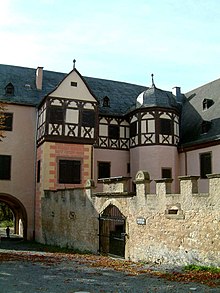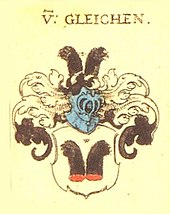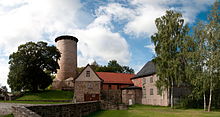Same gen. Of sootworm
The Gleichen gen. Von Rußwurm are a Thuringian nobility family who first appeared in 1418 with Hermann von Gliechen ( Gleichen ) .
On February 25, 1732 there was an imperial name and coat of arms association with those of Rußwurm for Heinrich von Gleichen, son-in-law of Ernst Friedrich von Rußwurm, the last of his line. On July 27, 1858, the family was enrolled in the baron class in the Kingdom of Bavaria . The family of Barons von Gleichen called von Rußwurm still exists today; They gained importance in the 19th century as descendants and administrators of Friedrich Schiller .
history
Whether the lords and (from 1858) barons of Gleichen were direct descendants or ministerials of the Counts of Gleichen (which died out in the male line in 1631) who had adopted the names of their masters (which often happened) has not been established.
According to Johann Friedrich Gauhe, they blossomed as a "split off branch of the Count's family of Gleichen in the Gotha principality ". The various coats of arms of the counts (silver crowned lion on a blue background) and the gentlemen / barons (two cut, bloody bear paws on a silver shield) speak for a tribal difference and make a servant relationship probable. The Counts of Tonna had received Gleichen Castle near Gotha in 1130 as a fief from the Archdiocese of Mainz and had been named after them since 1162. At the same time they owned several other castles and undoubtedly installed ministerials on them. In 1455 the counts moved their headquarters from Gleichen Castle back to their original ancestral seat, the chain castle in Gräfentonna .
Apparently, a knight family named von Gleichen had property in Ingersleben since 1380 , alongside the family of the lords of Ingersleben attested there between 1351 and 1518. The family with Hermann von Glieche was first mentioned in a document on August 24, 1418, who sired his wife with a court in Ingersleben .
The line of trunks begins towards the end of the 15th century with Curten von Gleichen to Tannrode and Ingersleben. The castle Tannroda was 1465-87 belonged to the counts of equals to Blankenhain, in whose family Else Vitztum, the sister of the previous owner Apel Vitzthum had married; For the latter, however, the castle was destroyed by citizens of Erfurt and Weimar because of his robbery. In 1487 it came into the possession of the von Bünau . After a fire in 1551, the castle was converted into a two-part castle, the Red Castle and the Blue Castle, and in 1597 the lords of Gleichen became co-owners. In the 18th century the castle was owned by the Dukes of Saxe-Weimar, from 1854 to 1945 the barons of Gleichen-Rußwurm again owned the Tannroda Castle and the associated manor.
Same gen. Of sootworm

The family married the von Rußwurm for the first time in 1658 , when the French Major General Hans Georg von Rußwurm married one of their equals. Shortly before his wedding, Rußwurm bought Bonnland (in what is now the Lower Franconian district of Bad Kissingen ) with Greifenstein Castle from Julius Albrecht von Thüngen. Bonnland was in the border area of the Hochstifte Fulda and Würzburg and belonged to the latter.
The Thuringian-Franconian sootworms died out in 1732 with the margravial Brandenburg-Kulmbach chief hunter Ernst Friedrich von Rußwurm. One of his daughters had married Heinrich von Gleichen, who succeeded his father-in-law in the office of chief hunter. On February 25, 1732 in Vienna he obtained the association of names and coats of arms with those of Rußwurm and since then has had a combined coat of arms from the four-sided shields of both families. As a result, Greifenstein Castle also came out on top. Since 1732, the family has therefore belonged to the Frankish imperial knighthood in the canton of Rhön-Werra .
The friendship of this family with the poet Friedrich von Schiller meant that he stayed at Greifenstein Castle for a long time in 1793. Finally, through the marriage of Schiller's youngest daughter Emilie to Adalbert von Gleichen-Rußwurm in 1828, a family bond was also established. She lived on Greifenstein from then until her death in 1872. Her son Heinrich Ludwig , a professor at the Grand Ducal Art School in Weimar, lived and painted at the palace; he was one of the first German impressionists . In 1895 his son Alexander von Gleichen-Rußwurm , a writer on cultural history , lived and worked on Greifenstein, who set up the Schiller Archive there. In 1938 Bonnland and its castle were relocated and became part of the Hammelburg military training area, which had existed since 1893. Alexander von Gleichen-Rußwurm and his wife had to vacate Greifenstein Castle, which had been in his family for over 450 years, and sell it to the army administration of the Wehrmacht for the expansion of the military training area. With the compensation he was able to rent the Villa Menschikow in Baden-Baden , where he died on October 25, 1947. The Schiller Archive was moved to Marbach am Neckar and formed the basis of today's German Literature Archive .
people
- Wilhelm Friedrich von Gleichen-Rußwurm (1717–1783), margravial Bavarian officer and natural scientist.
- Christian Ernst von Gleichen-Rußwurm (1719–1768), colonel of the Margrave of Bavaria
- Emilie von Gleichen-Rußwurm (1804–1872), youngest daughter of Friedrich and Charlotte Schiller . Married in 1828 to Heinrich Adalbert von Gleichen-Rußwurm (1803–1887)
- Ludwig von Gleichen-Rußwurm (1836–1901), Schiller's grandson, impressionist landscape painter
- Alexander von Gleichen-Rußwurm (1865–1947), great-grandson of Friedrich von Schiller; Writer, editor, translator and cultural philosopher
- Heinrich von Gleichen-Rußwurm (1882–1959), cousin of Alexander von Gleichen-Rußwurm, young conservative publicist
- Kurt von Gleichen-Rußwurm (1915–2006), journalist, advertising consultant and personnel consultant
Genealogical representation
Not yet continued and connected:
- Heinrich von Gleichen-Rußwurm (1681–1767), Bavarian privy councilor and chief hunter master, ⚭ Carolina Dorothea Sophie von Rußwurm (1693–1748), last of her family, heiress of Greifenstein Castle and Bonnland . Heinrich von Gleichen was the founder of the von Gleichen-Rußwurm line after the imperial name and coat of arms were merged with those of Rußwurm in 1732
- Wilhelm Friedrich von Gleichen-Rußwurm (1717–1783), head stable master of the Margrave of Bayreuth, natural scientist (biologist).
The connection to the Schiller family:

- Heinrich Adalbert von Gleichen-Rußwurm (1803–1887), ⚭ 1828 Emilie von Schiller (1804–1872), youngest daughter of Friedrich von Schiller and Charlotte von Lengefeld
-
Ludwig von Gleichen-Rußwurm (1836–1901), impressionist landscape painter, ⚭ 1859 Elisabeth von Thienen eagle fly
- Alexander von Gleichen-Rußwurm (1865–1947), writer, editor, translator and cultural philosopher, ⚭ 1895 Sophie von Thienen-Adlerflycht (niece of his mother Elisabeth von Thienen Adlerflycht)
-
Heinrich von Gleichen-Rußwurm (1882–1959), cousin of Alexander von Gleichen-Rußwurm, young conservative publicist
-
Kurt von Gleichen-Rußwurm (1915–2006), journalist, advertising consultant and personnel consultant
- Christoph von Gleichen-Rußwurm (* 1956), businessman, entrepreneur, publisher
- Philip von Gleichen-Rußwurm (* 1957), publisher
- Luise von Gleichen-Rußwurm (* 1959), teacher and writer
-
Kurt von Gleichen-Rußwurm (1915–2006), journalist, advertising consultant and personnel consultant
-
Ludwig von Gleichen-Rußwurm (1836–1901), impressionist landscape painter, ⚭ 1859 Elisabeth von Thienen eagle fly
coat of arms
The alliance coat of arms of the von Gleichen called Rußwurm from 1732 is quartered and shows in the 1st and 4th fields a monk kneeling in black with a rosary and an open prayer book in his hands (Rußwurm coat of arms), in the 2nd and 3rd field in silver 2 facing away from each other erect black bear paws (family coat of arms peers). Two helmets on it: on the right with black and gold blankets the monk, on the left with black and silver blankets the bear paws.
Order shield of the Red Eagle Order for Ernst von Gleichen in the Order Church of St. Georgen, Bayreuth
Possessions
- Property in Ingersleben from around 1400
- Tannroda Castle (1597 -? And again from 1854 to 1945)
- Greifenstein Castle in Bonnland (1732–1938)
- Krölpa Castle , (19th century, sold 1888)
literature
- Gothaisches Genealogisches Taschenbuch , Freiherrlicher Volume 1860 (with family table)
- Genealogical manual of the nobility , Adelslexikon , Vol. IV / 1978
Individual references, comments
- ^ Johann Friedrich Gauhe: Genealogisch-Historisches Adels-Lexicon . Publisher: Johann Friedrich Gleditsch, Leipzig 1740
- ^ Friedrich Klemm: Gleichen-Rußwurm, Wilhelm Friedrich Freiherr von. In: New German Biography (NDB). Volume 6, Duncker & Humblot, Berlin 1964, ISBN 3-428-00187-7 , p. 447 ( digitized version ). - Relationships (cousins) are also mentioned
- ^ Paul Ascherson: Gleichen-Rußwurm, Wilhelm Friedrich Freiherr von . In: Allgemeine Deutsche Biographie (ADB). Volume 9, Duncker & Humblot, Leipzig 1879, pp. 226-228.






